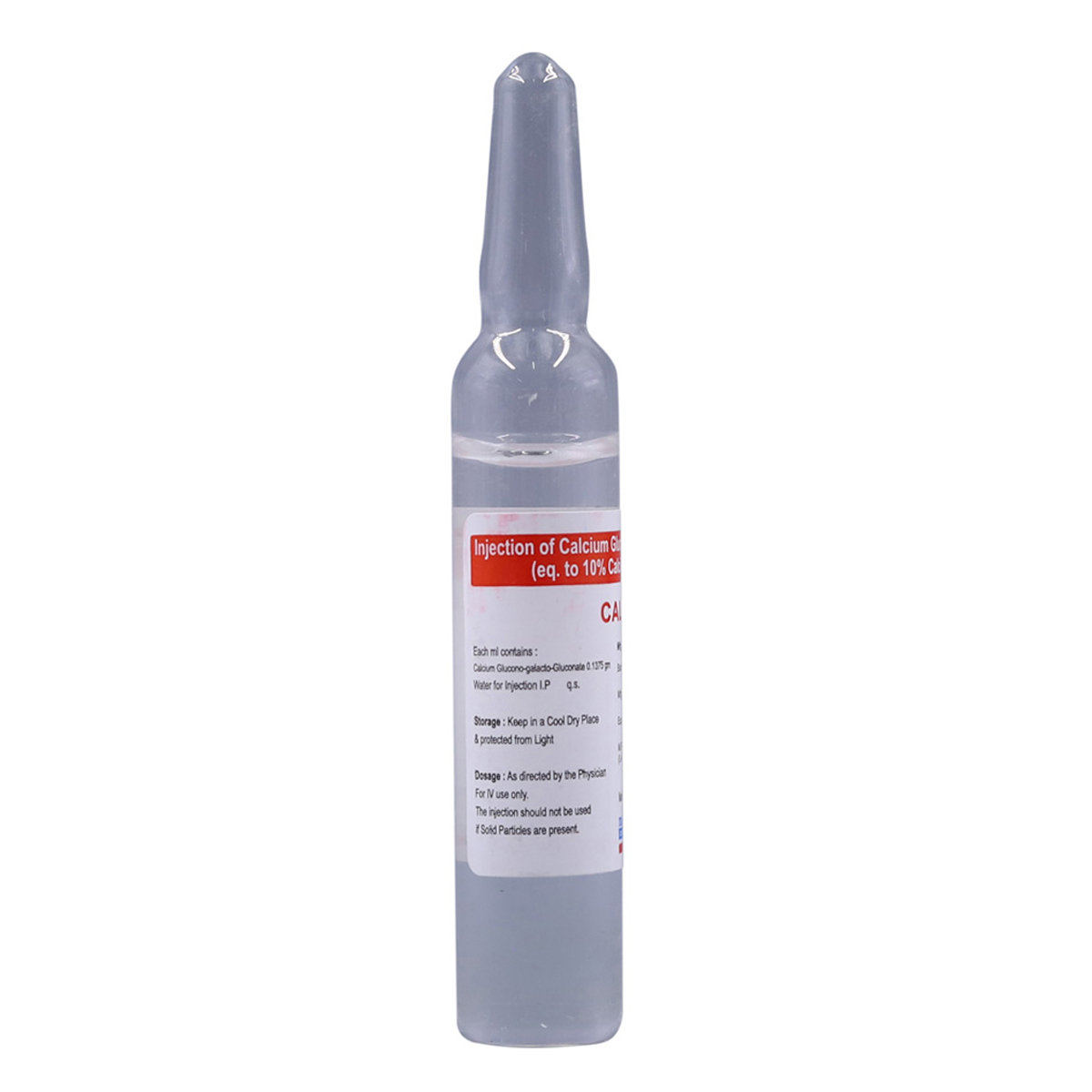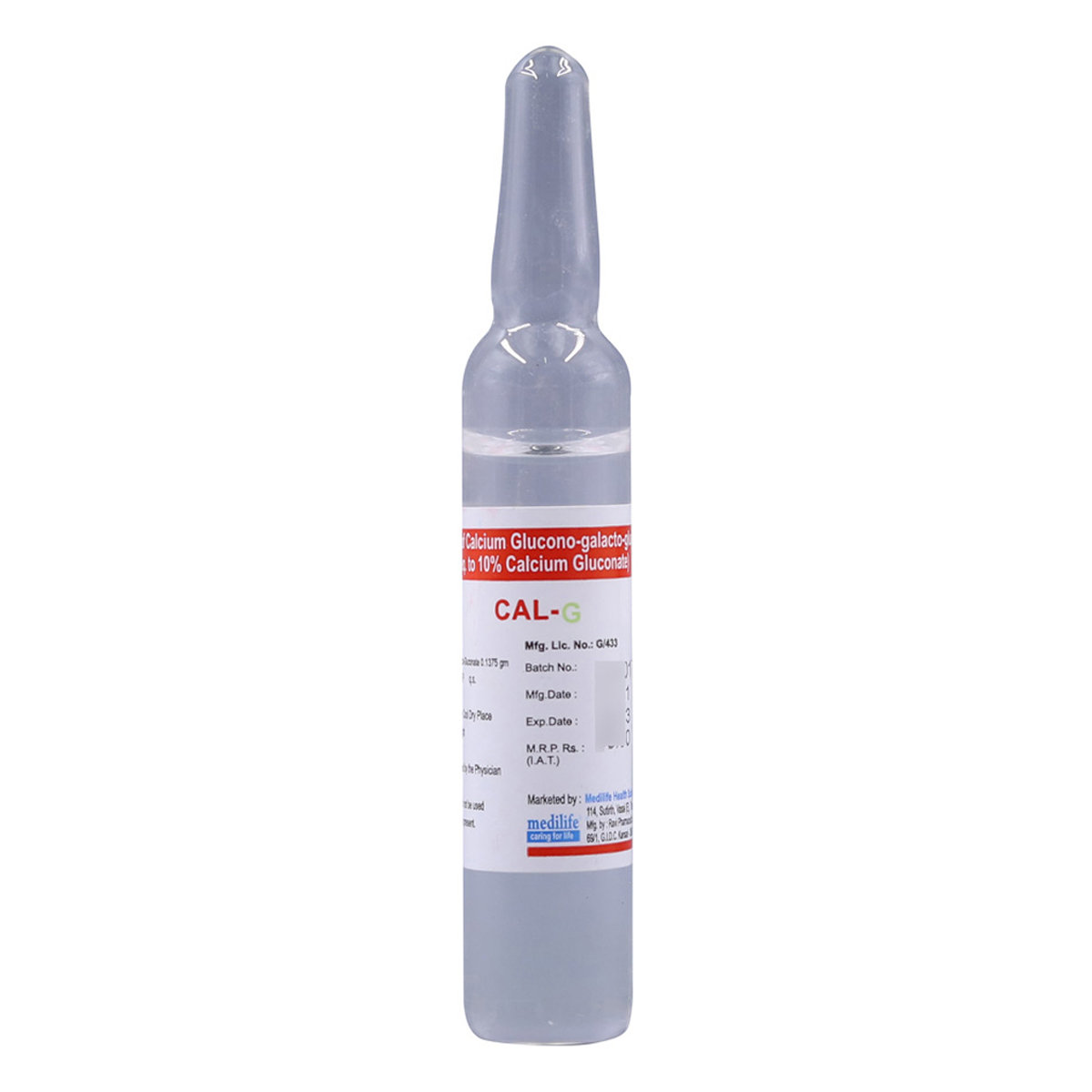Cal-G Injection 10 ml




MRP ₹90
(Inclusive of all Taxes)
₹13.5 Cashback (15%)
Provide Delivery Location
Online payment accepted
 Prescription drug
Prescription drugWhats That
Composition :
Manufacturer/Marketer :
Consume Type :
Expires on or after :
Return Policy :
About Cal-G Injection
Cal-G Injection is a mineral salt. It is a form of Calcium indicated for pediatric and adult patients to treat several medical conditions caused by low levels of Calcium in the body (hypocalcemia). Hypocalcemia is a treatable condition that happens when the calcium levels in your blood are too low. Many different health conditions can cause hypocalcemia.
Cal-G Injection contains Calcium Gluconate, administered to increase Calcium's blood levels in the body, thereby reducing the risk of calcium disorders due to lack of Calcium in the body.
A healthcare professional administers Cal-G Injection. Do not self-administer. Sometimes, you may experience local soft tissue inflammation, vasodilation, decreased blood pressure, bradycardia, cardiac arrhythmia, syncope, and cardiac arrest. Most of these side effects do not require medical attention and gradually resolve over time. However, if the side effects persist or worsen, please consult your doctor.
Before taking the Cal-G Injection, let your doctor know about all your medical conditions, sensitivities, and medications you are using. Cal-G Injection should not be used in pregnant and nursing mothers unless clearly necessary. So, inform your doctor if you are a pregnant or nursing mother. Your doctor will weigh the benefits and potential risks before recommending Cal-G Injection.
Uses of Cal-G Injection
Directions for Use
Key Benefits
Cal-G Injection contains Calcium Gluconate, which is administered to increase blood calcium levels in the body. It treats the body's calcium deficiency (hypocalcemia), thereby reducing the risk of calcium disorders due to low calcium levels. Cal-G Injection is also used to treat high potassium levels in the blood, or an overdose of magnesium sulfate (i.e. Epsom salts), sudden severe stomach pain and during heart resuscitation to strengthen the heart muscle. It can be used to prevent abnormal heartbeat (arrhythmia) due to high potassium levels in the blood (severe hyperkalaemia) and helps to restore normal heart function in an emergency (cardiac arrest) if potassium levels in the blood are too high. On the other hand, it can treat lead and fluoride poisoning.
Storage
Drug Warnings
Before receiving the Cal-G Injection, inform your doctor if you are allergic to Cal-G Injection or other medicines/foods. If you are pregnant or breastfeeding, think you may be pregnant, or plan to have a baby, ask your healthcare professional for advice before using this medicine. It is recommended not to use Calcium Gluconate Injection if the calcium levels in your blood or urine are above normal levels if you have severe heart disease if you have severe kidney disease, or if you suffer from galactosaemia (disorders of galactose metabolism). So, inform them about your medical conditions and the medications you are currently using to avoid potential interactions.
Drug-Drug Interactions
Drug-Drug Interactions
Login/Sign Up
Co-administration of Cal-G Injection 10 ml with Ceftriaxone can increase the risk of adverse effects.
How to manage the interaction:
Taking Ceftriaxone with Cal-G Injection 10 ml is not recommended, but can be taken together if prescribed by a doctor. However, consult your doctor if you experience any unusual symptoms contact a doctor immediately. Do not discontinue any medications without consulting a doctor.
Co-administration of Cal-G Injection 10 ml with Digitoxin may affect heart rhythm.
How to manage the interaction:
Although there is an interaction, Cal-G Injection 10 ml can be taken with digitoxin if prescribed by the doctor. Consult the prescriber if you experience symptoms of irregular heartbeat, blurred vision, chest tightness, nausea, and seizures. Do not discontinue the medication without consulting a doctor.
Co-administration of Dolutegravir and Cal-G Injection 10 ml may interfere with the absorption of Dolutegravir and reduce its effectiveness.
How to manage the interaction:
Although there is an interaction, Cal-G Injection 10 ml can be taken with Dolutegravir if prescribed by the doctor. However, take dolutegravir 2 hours before or 6 hours after taking Cal-G Injection 10 ml. Do not stop using any medications without talking to a doctor.
Co-administration of Eltrombopag and Cal-G Injection 10 ml may interfere with the absorption of Eltrombopag and reduce its effectiveness.
How to manage the interaction:
Although there is an interaction, Cal-G Injection 10 ml can be taken with Eltrombopag if prescribed by the doctor. However, take eltrombopag on an empty stomach, i.e., 2 hours before or 4 hours after taking Cal-G Injection 10 ml. Do not discontinue any medication without consulting a doctor.
Co-administration of Cal-G Injection 10 ml with Digoxin may affect heart rhythm.
How to manage the interaction:
Although there is an interaction, Cal-G Injection 10 ml can be taken with Digoxin if prescribed by the doctor. Consult the prescriber if you experience symptoms of irregular heartbeat, blurred vision, chest tightness, nausea, and seizures. Do not discontinue the medication without consulting a doctor.
Drug-Food Interactions
Drug-Food Interactions
Login/Sign Up
Diet & Lifestyle Advise
- Consume a well-balanced and healthy diet.
- Keep your weight under control with a BMI of 19.5-24.9
- Eat low-phosphorus foods such as sourdough bread, corn or rice cereals, cream of wheat, unsalted popcorn and some light-coloured sodas & lemonade.
- Avoid high-phosphorus foods, including bran cereals, oatmeal, nuts, sunflower seeds, whole-grain bread and dark-coloured colas.
- Limit or avoid alcohol consumption.
- Quitting smoking is the best strategy to lower the risk of illness.
Side Effects of Cal-G Injection
- Local soft tissue inflammation
- Necrosis (the death of body tissue)
- Calcinosis cutis (a group of disorders in which calcium deposits form in the skin)
- Calcification (calcium builds up in body tissue, causing the tissue to harden)
- Extravasation (drug leaks out of the vein and into the surrounding tissue).
- Vasodilation
- Decreased blood pressure
- Bradycardia
- Cardiac arrhythmia
- Syncope
- Cardiac arrest
Habit Forming
Therapeutic Class
All Substitutes & Brand Comparisons
Author Details
We provide you with authentic, trustworthy and relevant information
Drug-Diseases Interactions
Drug-Diseases Interactions
Login/Sign Up
Elevated serum calcium and phosphate levels that are above the solubility limit can cause calcium-phosphate precipitates to form in the body's vascular and renal systems as well as other soft tissues.
How to manage the interaction:
Therapy with Cal-G Injection 10 ml should be administered with extreme caution in patients with hyperphosphatemia (high phosphate in the blood). Clinical monitoring of serum calcium and phosphate concentrations is recommended.
Calcium is involved in cardiac muscle contraction and electrical impulse conduction. Patients with heart illness should receive therapy with calcium salt formulations (especially IV) with caution.
How to manage the interaction:
Therapy with Cal-G Injection 10 ml (particularly IV) should be administered cautiously to patients with cardiac disease. It should be administered slowly and at reduced dosages in patients with cardiac disease.
Active transport and passive diffusion are both used to absorb calcium from the gastrointestinal system. The absorption of oral calcium formulations can be decreased by malabsorption syndromes (celiac disease, GI resection), vitamin D, parathyroid hormone, or calcitonin deficiency, or an alkaline gastric pH (achlorhydria, carbonate, or phosphate salts).
How to manage the interaction:
Malabsorption may decrease the absorption of Cal-G Injection 10 ml.
FAQs
Cal-G Injection contains Calcium Gluconate, which is administered to increase Calcium's blood levels in the body, thereby reducing the risk of calcium disorders due to lack of Calcium in the body.
Calcium Gluconate is a mineral salt, which is administered to increase blood calcium levels in the body. It is used to treat the body's calcium deficiency (hypocalcemia), thereby reducing the risk of calcium disorders due to low calcium levels.
Calcium Gluconate can be used in the treatment of lead and fluoride poisoning.
Cal-G Injection is to help restore normal heart function in an emergency (cardiac arrest) if potassium levels in the blood are too high.
Drug-Drug Interactions Checker List
- CABOTEGRAVIR
- DOLUTEGRAVIR
- CEFTRIAXONE
- DIGITOXIN
- DIGOXIN
Special Advise
- Your doctor may check the amount of electrolytes (e.g. calcium) in your blood at regular intervals.
Disease/Condition Glossary
Hypocalcemia: Hypocalcemia is a curable condition that occurs when the calcium levels in your blood are abnormally low. Hypocalcemia can result from a variety of medical disorders. The most common symptoms of hypocalcemia are paresthesia, muscle spasms, cramps, tetany, circumoral numbness, and convulsions.

Have a query?
Buy best Nutrition & Metabolism products by
VITAMINS AND MINERALS
OTHER SUPPLEMENTS
HEMATINICS
BONE & JOINT SUPPLEMENTS
WOMEN HEALTH SUPPLEMENTS
AMINO ACID SUPPLEMENTS
GASTRIC DISORDERS SUPPLEMENTS
IMMUNE HEALTH SUPPLEMENTS
CARDIAC SUPPLEMENTS
WEIGHT LOSS AND WEIGHT GAIN
DIABETICS SUPPLEMENTS
RESPIRATORY DISEASE SUPPLEMENTS
APPETITE SUPPRESSANTS
APPETITE STIMULANTS
NUTRITIONAL SUPPLEMENTS
Alniche Life Sciences Pvt Ltd
Abbott India Ltd
Intas Pharmaceuticals Ltd
Alkem Laboratories Ltd
Elder Pharmaceuticals Ltd
Fourrts India Laboratories Pvt Ltd
Zydus Cadila
Leeford Healthcare Ltd
Akumentis Healthcare Ltd
Cipla Ltd
La Renon Healthcare Pvt Ltd
Eris Life Sciences Ltd
Olcare Laboratories Pvt Ltd
East West Pharma India Pvt Ltd
Indoco Remedies Ltd
Lupin Ltd
Macleods Pharmaceuticals Ltd
Aristo Pharmaceuticals Pvt Ltd
Dr Reddy's Laboratories Ltd
Sun Pharmaceutical Industries Ltd
Yuventis Pharmaceuticals
Zee Laboratories Ltd
Meyer Organics Pvt Ltd
Unipark Biotech Pvt Ltd
Zydus Healthcare Ltd
Mankind Pharma Pvt Ltd
Micro Labs Ltd
Adonis Laboratories Pvt Ltd
Emcure Pharmaceuticals Ltd
Levin Life Sciences Pvt Ltd
Sanatra Healthcare Ltd
Medishri Healthcare Pvt Ltd
Anglo French Drugs & Industries Ltd
Koye Pharmaceuticals Pvt Ltd
Maxamus Pharma Pvt Ltd
Spa Newtraceuticals Pvt Ltd
Corona Remedies Pvt Ltd
Vasu Organics Pvt Ltd
DR Johns Lab Pharma Pvt Ltd
Gh Vision Care Life Sciences
Glenon Healthcare
Albert David Ltd
Apple Life Sciences
Ardent Life Sciences Pvt Ltd
BSA Pharma Inc
Biophar Lifesciences Pvt Ltd
Brio Bliss Life Science Pvt Ltd
Cadila Healthcare Ltd
Innovcare Life Sciences Pvt Ltd
Medley Pharmaceuticals Ltd
Quality Pharma
Signova Pharma
Tas Med India Pvt Ltd
Torrent Pharmaceuticals Ltd
Troikaa Pharmaceuticals Ltd
Aarux Pharmaceuticals Pvt Ltd
Ajanta Pharma Ltd
Altcare Pharmaceuticals Pvt Ltd
Bioceutics Inc
Fenestra Pharmaceuticals Pvt Ltd
Friska Nutraceuticals Pvt Ltd
Intra Labs India Pvt Ltd
Mova Pharmaceutical Pvt Ltd
Pharmed Ltd
Steris Healthcare
Acme Pharmaceuticals
Cachet Pharmaceuticals Pvt Ltd
Dr Morepen Ltd
Morepen Laboratories Ltd
Syndicate Life Sciences Pvt Ltd
Tricept Life Sciences Pvt Ltd
Winmark Healthcare Pvt Ltd
Zeno Bio Life Science Pvt Ltd
Alembic Pharmaceuticals Ltd
Alteus Biogenics Pvt Ltd
British Biologicals
Chemo Healthcare Pvt Ltd
Daffoworth Pharmaceutical Pvt Ltd
Daris Biocare
Femura Pharmaceuticals Pvt Ltd
Gynofem Healthcare Pvt Ltd
Inex Medicaments Pvt Ltd
Intra Life Pvt Ltd
Mediart Life Sciences Pvt Ltd
Orchis Pharmaceuticals
Prevego Healthcare & Research Pvt Ltd
Raptakos Brett & Co Ltd
Sanofi India Ltd
Unichem International
Ventus Pharma
Waylon Biotech Pvt Ltd
Zuventus Healthcare Ltd
Axonav Healthcare Llp
Canvarzys Healthcare Ltd
Capital Pharma
Centaur Pharmaceuticals Pvt Ltd
GlaxoSmithKline Pharmaceuticals Ltd
Glenmark Pharmaceuticals Ltd
Healing Pharma
Iva Healthcare Pvt Ltd
Specialty Supplements
CALCIUM
VITAMIN B12
VITAMIN B9
SPECIALITY SUPPLEMENT
VITAMIN D
IRON
FISH OIL OMEGA
VITAMIN B
ZINC
VITAMIN C
VITAMIN E
COLLAGEN
Cod Liver Oil
MAGNESIUM
VITAMIN B5
VITAMIN B1
Appetite Suppressant
VITAMIN A
VITAMIN K
Fat Burner
WOMEN & MOTHER NUTRITION DRINK
APPETITE STIMULANT
BODY GEL
NUTRITION DRINK
VITAMIN B6
Chromium
ENERGY DRINK
MULTIVITAMIN
SPECIALITY NUTRITION DRINK
Shampoo
Soap
Alcohol
Safe if prescribed
Avoid consumption of alcohol while on treatment with this medicine.
Pregnancy
Consult your doctor
Cal-G Injection should not be used during pregnancy unless clearly necessary. So, inform your doctor if you are pregnant or suspect pregnancy. Your doctor will weigh the benefits and potential risks before recommending Cal-G Injection.
Breast Feeding
Consult your doctor
Cal-G Injection should not be used in nursing mothers unless clearly necessary. So, inform your doctor if you are breastfeeding. Your doctor will weigh the benefits and potential risks before recommending Cal-G Injection.
Driving
Safe if prescribed
Cal-G Injection will not affect your ability to drive.
Liver
Consult your doctor
If you have a pre-existing or a history of liver disease, inform your doctor before taking Cal-G Injection. Your doctor may adjust the dose of this medicine based on your condition.
Kidney
Consult your doctor
If you have a pre-existing or a history of kidney conditions, inform your doctor before taking Cal-G Injection. Your doctor may adjust the dose of this medicine based on your condition.
Children
Safe if prescribed
Please consult your doctor. Your doctor will weigh the risks and benefits before prescribing this medicine to your child.





